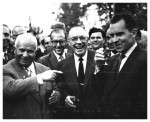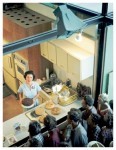
The Kitchen Debate refers to a 1959 exchange between United States vice-president Richard Nixon and Soviet leader Nikita Khrushchev. In this informal conversation, carried out in front of press reporters and television cameras, Nixon and Khrushchev debated the merits of their respective ideologies. The context for their meeting was a 1958 cultural agreement between the US and USSR, committing to a freer exchange of ideas and information. As part of this agreement, two trade exhibitions were scheduled for mid-1959: a Soviet exhibition in New York and an American exhibition in Moscow. The Soviets ploughed the equivalent of $US12 million into their exhibition, held in June 1959. Hosted on a custom-built venue spanning four acres, the Soviet centrepiece was Sputnik I, which two years earlier had orbited the Earth as the first man-made satellite. There were also displays of Russian farming techniques and production technology, as well as cultural performances like music, theatre and dance. Thousands of Americans piled through the exhibition to get a first-hand glimpse of Soviet life. Many left derogatory comments in the visitors’ books, one writing that he would have liked to have seen Russia’s “labour camps”.
The American exhibition opened in Moscow in late July 1959 and was attended by Khrushchev and Nixon. Both had held high office for around six years, though Nixon’s rise had been steeper and more rapid than his Russian counterpart. A lawyer by training, Nixon was elected to the House of Representatives in 1947 and attracted publicity as an active anti-communist. During his time in Congress, Nixon supported legislation to limit and monitor the activities of trade unions, then became a leading figure in the House Un-American Activities Committee (HUAC) during its investigation and prosecution of Alger Hiss. At the height of the Red Scare, Nixon’s popularity rose on the back of his anti-communist activities. In 1950 he transferred to the US Senate, which many interpreted as a stepping-stone to the White House. Nixon became Dwight Eisenhower‘s presidential running mate in 1952 and was elected as vice-president in November.

Nixon arrived in Moscow on July 23rd. Prior to visiting the American exhibition, he attended a public reception hosted by Khrushchev. This event was outwardly friendly but, as one might expect, there were several prickly moments. Khrushchev was known for his combative and sarcastic manner – and having Nixon, one of the most vocal of America’s anti-communist agitators, as his guest proved too good an opportunity to pass. Khrushchev welcomed the vice-president to “a land of captive people”, a sarcastic reference to one of Eisenhower’s earlier remarks about the Soviet bloc. The Soviet leader then went on to deride America as “imperialists”, “monopolists” and interferers in the affairs of communist nations. Nixon did not rise to the bait in his reply speech, which was calm and conciliatory. But when he was heckled by Russians in the audience, Nixon challenged them about freedom of speech.

The American exhibition, which opened the following day, was funded largely by sponsorship from large corporations like Ford, General Motors, IBM, General Electric and Westinghouse. The US government itself contributed $3.5 million. The Soviets hindered construction of the exhibition, allocating a ten-acre site in a remote forest, well outside Moscow. As a result, much of the US government-supplied funds were spent on building access roads, clearing trees and connecting power and water. The exhibition building, a huge geodesic dome, was completed by a joint US-Soviet construction team. It soon fell behind schedule. The Americans complained that their Russian counterparts, several of whom were women, were lazy, poorly equipped and unable to follow instructions.
“The conversation began innocently enough. We discussed the relative merits of washing machines. Then I decided that this was as good a place as any to answer the charges that had been made in the Soviet press: that only ‘the rich’ in the United States could afford such a house as this. I made the point that this was a typical house in the United States, costing $14,000, which could be paid over 25 or 30 years. Most US veterans of World War II have bought houses like this, in the $10,000 to $15,000 range, I told him, adding that most any steelworker could buy one.”
Richard Nixon
Under the terms of the US-Soviet agreement, no overt political material was displayed in either exhibition. Nevertheless, both governments viewed the exhibitions as opportunities for Cold War propaganda. The American exhibition was less concerned with industrial and technical achievements than promoting the idea that Americans enjoyed a better standard of living. Because of this, there was a strong focus on consumer goods like motor cars, electrical appliances and labour-saving devices. An entire suburban house was constructed inside the exhibition building, to offer Russian visitors a look inside the average American home. This model home contained the latest products: a dishwasher, colour television, frozen meals and Pepsi-Cola. There were displays of American culture including films, television programs, art, books and games.

The American exhibition was very popular with Soviet citizens. Almost three million Russians attended, despite a lack of easy transportation from Moscow. There were long queues for free samples of American food and drink, like Pepsi-Cola. The book displays had to be constantly restocked because of petty theft. Four sets of Monopoly – ironically the most capitalist board game of its era – were also pilfered and had to be replaced. As with the Soviet exhibition in New York, some Russian visitors left negative guestbook comments. The main criticisms were that American consumer goods were funded by American imperialism and produced by the exploitation of workers.
Khrushchev and Nixon toured the exhibition the day before its public opening, with a large press contingent in tow. While in the display home, the two men gave impromptu comments that morphed into a friendly but sometimes heated exchange. They debated the contents of the exhibition, the relative development of their two countries and the merits of communism and capitalism. Among the specifics were kitchen appliances and the role of women:
Nixon: “I want to show you this kitchen. It is like those of our houses in California.
Khrushchev: We have such things.”
Nixon (pointing to a dishwasher): “This is our newest model. This is the kind which is built in thousands of units for direct installations in the houses. In America, we like to make life easier for women.”
Khrushchev: “Your capitalistic attitude toward women does not exist under communism.”
Nixon: “I think that this attitude towards women is universal. What we want to do, is make life more easy for our housewives.”
The durability of houses:
Nixon: “This house can be bought for $14,000, and most Americans can buy a home in the bracket of $10,000 to $15,000. Let me give you an example that you can appreciate. Our steelworkers as you know, are now on strike. But any steelworker could buy this house. They earn $3 an hour. This house costs about $100 a month to buy on a contract running 25 to 30 years.”
Khrushchev: “We have steel workers and peasants who can afford to spend $14,000 for a house. Your American houses are built to last only 20 years so builders could sell more new houses. We build firmly. We build for our children and grandchildren.”
Nixon: “American houses last for more than 20 years, but even so, after 20 years many Americans want a new house or a new kitchen. Their kitchen is obsolete by that time. The American system is designed to take advantage of new inventions and new techniques.”
And the technical skill of their respective nations:
Nixon: “There are some instances where you may be ahead of us. For example, in the development of the thrust of your rockets for the investigation of outer space. There may be some instances, for example, colour television, where we’re ahead of you. But in order for both of us to benefit…”
Khrushchev: “No, in rockets we’ve passed you by. And in the technology…”
Nixon: “You see, you never concede anything!”
This exchange, which became known as the ‘Kitchen Debate’, was recorded on Ampex colour videotape, itself a new American invention. Nixon, who during the discussion had called for a freer exchange of ideas between the two countries, promised Khrushchev that his remarks would be broadcast in full to the American people, a promise that was later fulfilled. The ‘Kitchen Debate’ was also broadcast on Soviet television, though some of Nixon’s remarks were censored. The exchange was a rare one: two Cold War leaders, both vehement defenders of their political and economic systems, communicating their political views in person and in public.

1. The Kitchen Debate was an informal exchange between US vice-president Richard Nixon and Soviet leader Nikita Khrushchev in July 1959.
2. This exchange occurred before television cameras at an American exhibition outside Moscow. This was the second of two cross-cultural exhibitions, the Soviets also holding one in New York.
3. These exhibitions were intended to showcase the economies, technical developments and culture of each nation. Though political messages were banned, they still served as propaganda devices.
4. The debate took place in an American display home, near a model kitchen featuring modern electrical appliances, hence the name ‘Kitchen Debate’.
5. Nixon and Khrushchev engaged in banter about the respective merits of living and working in each nation. The debate was generally friendly, though there were some heated moments.

A transcript of the Nixon-Khrushchev ‘Kitchen Debate’ (1959)
Content on this page is © Alpha History 2018. This content may not be republished or distributed without permission. For more information please refer to our Terms of Use.
This page was written by Jennifer Llewellyn, Jim Southey and Steve Thompson. To reference this page, use the following citation:
J. Llewellyn et al, “The Kitchen Debate”, Alpha History, accessed [today’s date], https://alphahistory.com/coldwar/kitchen-debate/.
